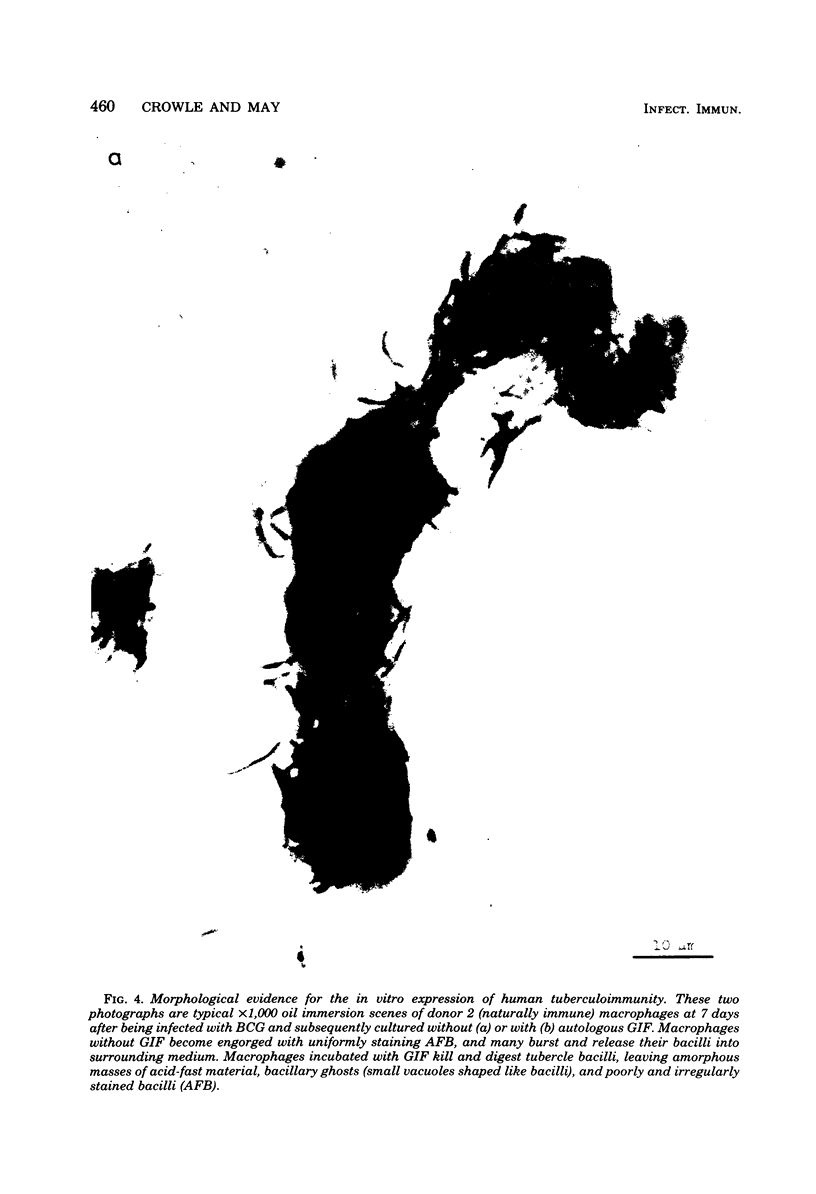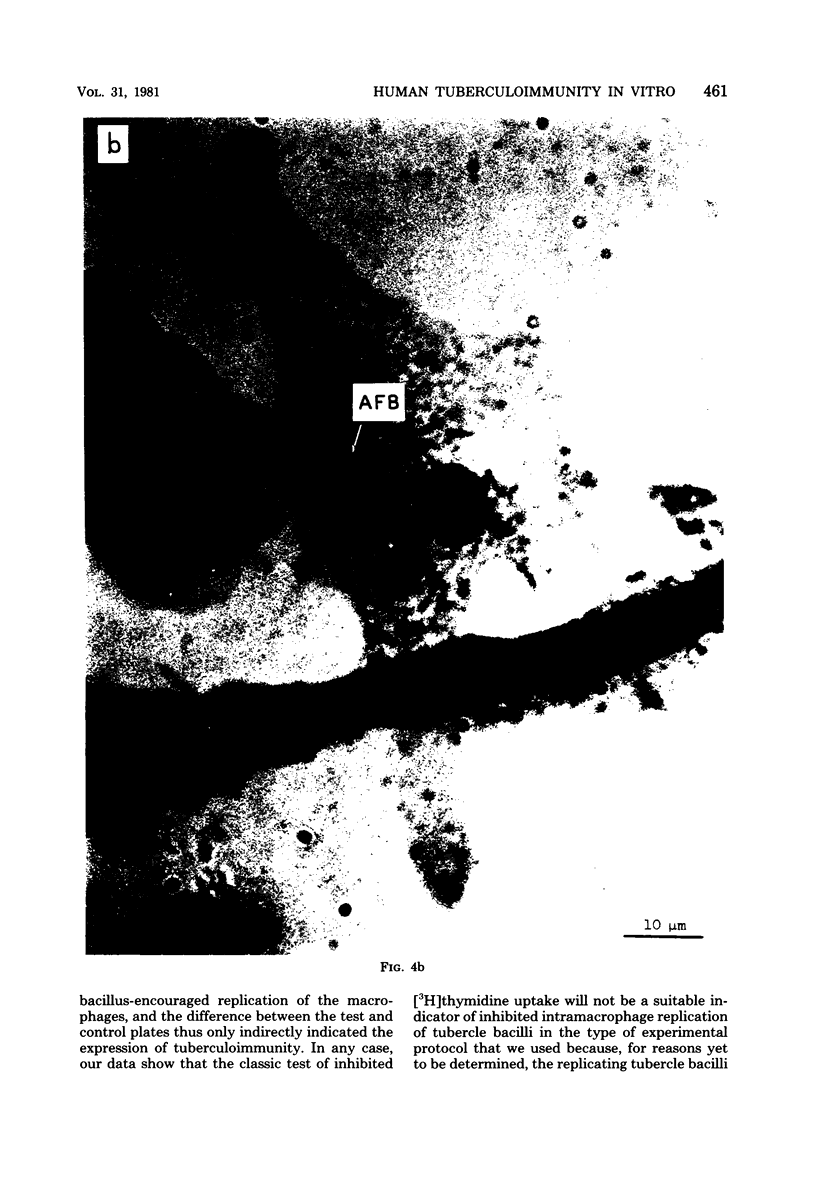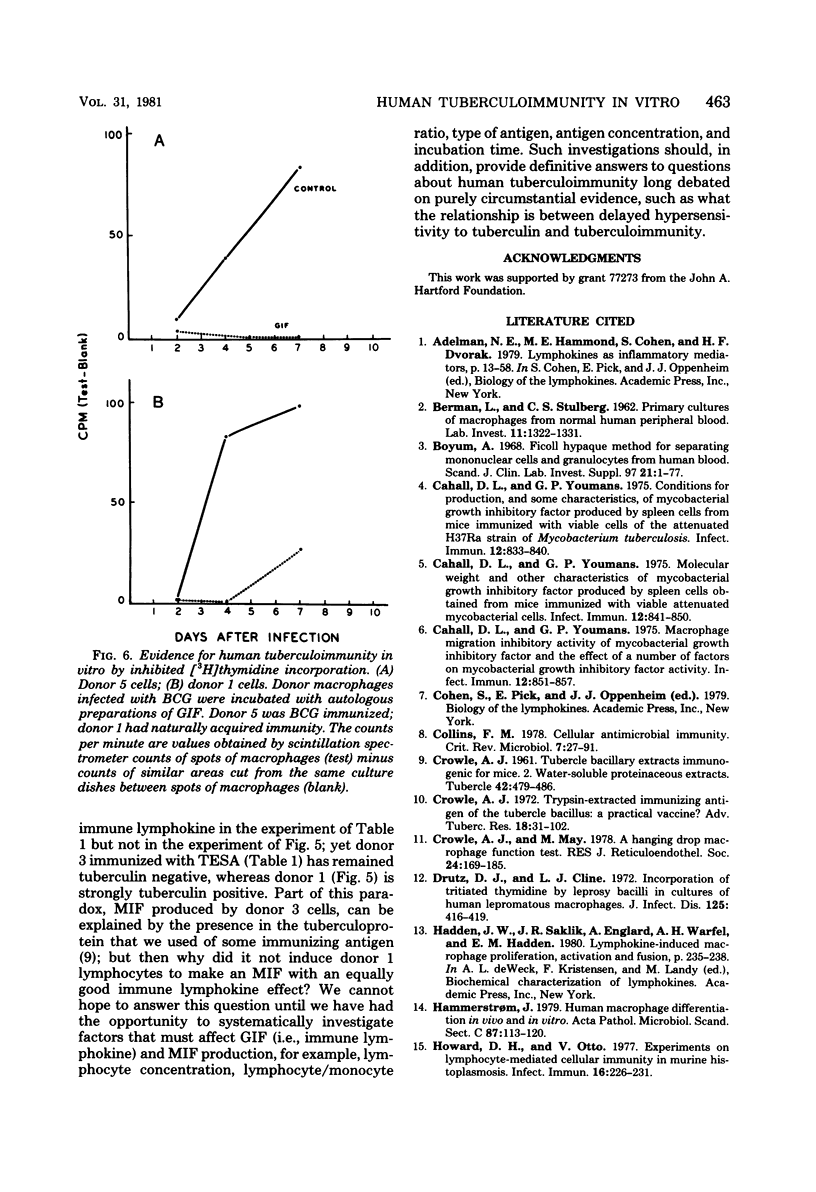Abstract
In this paper a method for studying human tuberculoimmunity in vitro is described. Results from its use support an explanation for human tuberculoimmunity that is like that for mouse tuberculoimmunity: that immune lymphocytes are stimulated by being cultured with immunizing antigen to make a lymphokine which enables syngeneic macrophages to kill intracellular tubercle bacilli. This method uses antigen-responding lymphocytes and effector monocytes taken in the same original 20-ml sample of venous blood. These cells are cultured separately, the lymphocytes for 72 h with antigen to make immune lymphokine and the monocytes for 7 days to become macrophages. The macrophages are then infected with attenuated or virulent tubercle bacilli and cultured for 7 days more in medium with or without the immune lymphokine. Without it they are unable to control intracellular replication of the bacilli, whereas with it they do. This lymphokine was produced only by lymphocytes of immune subjects, of whom there were three kinds: tuberculin positive naturally immunized, Mycobacterium bovis BCG immunized, and trypsin-extracted bacillary antigen immunized. This method for detecting human tuberculoimmunity in vitro should be useful for comparing experimental vaccines and for studying cellular and molecular mechanisms of human tuberculoimmunity under better controlled conditions than hitherto have been possible.
Full text
PDF











Images in this article
Selected References
These references are in PubMed. This may not be the complete list of references from this article.
- BERMAN L., STULBERG C. S. Primary cultures of macrophages from normal human peripheral blood. Lab Invest. 1962 Dec;11:1322–1331. [PubMed] [Google Scholar]
- CROWLE A. J. Tubercle bacillary extracts immunogenic for mice. 2. Water-soluble proteinaceous extracts. Tubercle. 1961 Dec;42:479–486. doi: 10.1016/s0041-3879(61)80137-2. [DOI] [PubMed] [Google Scholar]
- Cahall D. L., Youmans G. P. Conditions for production, and some characteristics, of mycobacterial growth inhibitory factor produced by spleen cells from mice immunized with viable cells of the attenuated H37Ra strain of Mycobacterium tuberculosis. Infect Immun. 1975 Oct;12(4):833–840. doi: 10.1128/iai.12.4.833-840.1975. [DOI] [PMC free article] [PubMed] [Google Scholar]
- Cahall D. L., Youmans G. P. Macrophage migration inhibitory activity of mycobacterial growth inhibitory factor and the effect of a number of factors on mycobacterial growth inhibitory factor activity. Infect Immun. 1975 Oct;12(4):851–857. doi: 10.1128/iai.12.4.851-857.1975. [DOI] [PMC free article] [PubMed] [Google Scholar]
- Cahall D. L., Youmans G. P. Molecular weight and other characteristics of mycobacterial growth inhibitory factor produced by spleen cells obtained from mice immunized with viable attenuated mycobacterial cells. Infect Immun. 1975 Oct;12(4):841–850. doi: 10.1128/iai.12.4.841-850.1975. [DOI] [PMC free article] [PubMed] [Google Scholar]
- Collins F. M. Cellular antimicrobial immunity. CRC Crit Rev Microbiol. 1978;7(1):27–91. doi: 10.3109/10408417909101177. [DOI] [PubMed] [Google Scholar]
- Crowle A. J., May M. A hanging drop macrophage function test. J Reticuloendothel Soc. 1978 Aug;24(2):169–185. [PubMed] [Google Scholar]
- Drutz D. J., Cline M. J. Incorporation of tritiated thymidine by leprosy bacilli in cultures of human lepromatous macrophages. J Infect Dis. 1972 Apr;125(4):416–419. doi: 10.1093/infdis/125.4.416. [DOI] [PubMed] [Google Scholar]
- Howard D. H., Otto V. Experiments on lymphocyte-mediated cellular immunity in murine histoplasmosis. Infect Immun. 1977 Apr;16(1):226–231. doi: 10.1128/iai.16.1.226-231.1977. [DOI] [PMC free article] [PubMed] [Google Scholar]
- Johnson W. D., Jr, Mei B., Cohn Z. A. The separation, long-term cultivation, and maturation of the human monocyte. J Exp Med. 1977 Dec 1;146(6):1613–1626. doi: 10.1084/jem.146.6.1613. [DOI] [PMC free article] [PubMed] [Google Scholar]
- Krahenbuhl J. L., Rosenberg L. T., Remington J. S. The role of thymus-derived lymphocytes in the in vitro activation of macrophages to kill Listeria monocytogenes. J Immunol. 1973 Oct;111(4):992–995. [PubMed] [Google Scholar]
- MACKANESS G. B., SMITH N., WELLS A. Q. The growth of intracellular tubercle bacilli in relation to their virulence. Am Rev Tuberc. 1954 Apr;69(4):479–494. doi: 10.1164/art.1954.69.4.479. [DOI] [PubMed] [Google Scholar]
- Nacy C. A., Meltzer M. S. Macrophages in resistance to rickettsial infection: macrophage activation in vitro for killing of Rickettsia tsutsugamushi. J Immunol. 1979 Dec;123(6):2544–2549. [PubMed] [Google Scholar]
- SUTER E. Interaction between phagocytes and pathogenic microorganisms. Bacteriol Rev. 1956 Jun;20(2):94–132. doi: 10.1128/br.20.2.94-132.1956. [DOI] [PMC free article] [PubMed] [Google Scholar]
- Stadecker M. J., Unanue E. R. The regulation of thymidine secretion by macrophages. J Immunol. 1979 Aug;123(2):568–571. [PubMed] [Google Scholar]
- Talwar G. P., Krishnan A. D., Gupta P. D. Quantitative evaluation of the progress of intracellular infection in vitro: incorporation of 3H-thymidine into deoxyribonucleic acid by Mycobacterium leprae in cultivated blood monocytes. Infect Immun. 1974 Jan;9(1):187–191. doi: 10.1128/iai.9.1.187-191.1974. [DOI] [PMC free article] [PubMed] [Google Scholar]
- Treves A. J., Feldman M., Kaplan H. S. Primary cultures of human spleen macrophages in vitro. J Immunol Methods. 1976;13(3-4):279–287. doi: 10.1016/0022-1759(76)90075-2. [DOI] [PubMed] [Google Scholar]
- Turcotte R., Des Ormeaux Y., Borduas A. G. Partial characterization of a factor extracted from sensitized lymphocytes that inhibits the growth of Mycobacterium tuberculosis within macrophages in vitro. Infect Immun. 1976 Aug;14(2):337–344. doi: 10.1128/iai.14.2.337-344.1976. [DOI] [PMC free article] [PubMed] [Google Scholar]






